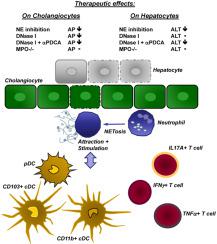当前位置:
X-MOL 学术
›
J. Autoimmun.
›
论文详情
Our official English website, www.x-mol.net, welcomes your feedback! (Note: you will need to create a separate account there.)
Blockade of neutrophil extracellular trap components ameliorates cholestatic liver disease in Mdr2 (Abcb4) knockout mice
Journal of Autoimmunity ( IF 12.8 ) Pub Date : 2024-04-22 , DOI: 10.1016/j.jaut.2024.103229 Edith Hintermann , Camilla Tondello , Sina Fuchs , Monika Bayer , Josef M. Pfeilschifter , Richard Taubert , Martin Mollenhauer , Roland P.J. Oude Elferink , Michael P. Manns , Urs Christen
Journal of Autoimmunity ( IF 12.8 ) Pub Date : 2024-04-22 , DOI: 10.1016/j.jaut.2024.103229 Edith Hintermann , Camilla Tondello , Sina Fuchs , Monika Bayer , Josef M. Pfeilschifter , Richard Taubert , Martin Mollenhauer , Roland P.J. Oude Elferink , Michael P. Manns , Urs Christen

|
Primary sclerosing cholangitis (PSC) is an (auto)immune-mediated cholestatic liver disease with a yet unclear etiology. Increasing evidence points to an involvement of neutrophils in chronic liver inflammation and cirrhosis but also liver repair. Here, we investigate the role of the neutrophil extracellular trap (NET) component myeloperoxidase (MPO) and the therapeutic potential of DNase I and of neutrophil elastase (NE) inhibitor GW311616A on disease outcome in the multidrug resistance 2 knockout () mouse, a PSC animal model. Initially, we observed the recruitment of MPO expressing cells and the formation of NETs in liver biopsies of PSC patients and in livers. Furthermore, sera of mice contained perinuclear anti-neutrophil cytoplasmic antibody (-ANCA)-like reactivity similar to PSC patient sera. Also, hepatic NE activity was significantly higher in mice than in wild type littermates. Flow cytometry analyses revealed that during disease development a highly active neutrophil subpopulation established specifically in the liver of mice. However, absence of their MPO activity, as in MPO-deficient mice, showed no effect on hepatobiliary disease severity. In contrast, clearance of extracellular DNA by DNase I reduced the frequency of liver-resident neutrophils, plasmacytoid dendritic cells (pDCs) and CD103 conventional DCs and decreased cholangiocyte injury. Combination of DNase I with a pDC-depleting antibody was additionally hepatocyte-protective. Most importantly, GW311616A, an orally bioavailable inhibitor of human NE, attenuated hepatobiliary injury in a TNFα-dependent manner and damped hyperproliferation of biliary epithelial cells. Further, hepatic immigration and activity of CD11b DCs as well as the secretion of IFNγ by hepatic CD4 and CD8 T cells were reduced. Our findings delineate neutrophils as important participants in the immune cell crosstalk that drives cholestatic liver disease and identify NET components as potential therapeutic targets.
中文翻译:

阻断中性粒细胞胞外陷阱成分可改善 Mdr2 (Abcb4) 敲除小鼠的胆汁淤积性肝病
原发性硬化性胆管炎(PSC)是一种(自身)免疫介导的胆汁淤积性肝病,其病因尚不清楚。越来越多的证据表明,中性粒细胞参与慢性肝脏炎症和肝硬化,也参与肝脏修复。在这里,我们研究了中性粒细胞胞外陷阱 (NET) 成分髓过氧化物酶 (MPO) 以及 DNase I 和中性粒细胞弹性蛋白酶 (NE) 抑制剂 GW311616A 对多药耐药 2 敲除 (PSC) 小鼠疾病结果的治疗潜力。动物模型。最初,我们在 PSC 患者的肝活检和肝脏中观察到 MPO 表达细胞的募集和 NET 的形成。此外,小鼠血清含有与 PSC 患者血清相似的核周抗中性粒细胞胞质抗体 (-ANCA) 样反应性。此外,小鼠的肝脏 NE 活性显着高于野生型同窝小鼠。流式细胞术分析表明,在疾病发展过程中,在小鼠肝脏中专门建立了高度活跃的中性粒细胞亚群。然而,如 MPO 缺陷小鼠一样,它们缺乏 MPO 活性,对肝胆疾病的严重程度没有影响。相比之下,DNase I 清除细胞外 DNA 会降低肝脏驻留中性粒细胞、浆细胞样树突状细胞 (pDC) 和 CD103 常规 DC 的频率,并减少胆管细胞损伤。 DNase I 与 pDC 消耗抗体的组合还具有肝细胞保护作用。最重要的是,GW311616A 是一种口服生物可利用的人 NE 抑制剂,以 TNFα 依赖性方式减轻肝胆损伤,并抑制胆管上皮细胞的过度增殖。此外,CD11b DC 的肝迁移和活性以及肝 CD4 和 CD8 T 细胞分泌的 IFNγ 均减少。我们的研究结果表明,中性粒细胞是导致胆汁淤积性肝病的免疫细胞串扰的重要参与者,并将 NET 成分确定为潜在的治疗靶点。
更新日期:2024-04-22
中文翻译:

阻断中性粒细胞胞外陷阱成分可改善 Mdr2 (Abcb4) 敲除小鼠的胆汁淤积性肝病
原发性硬化性胆管炎(PSC)是一种(自身)免疫介导的胆汁淤积性肝病,其病因尚不清楚。越来越多的证据表明,中性粒细胞参与慢性肝脏炎症和肝硬化,也参与肝脏修复。在这里,我们研究了中性粒细胞胞外陷阱 (NET) 成分髓过氧化物酶 (MPO) 以及 DNase I 和中性粒细胞弹性蛋白酶 (NE) 抑制剂 GW311616A 对多药耐药 2 敲除 (PSC) 小鼠疾病结果的治疗潜力。动物模型。最初,我们在 PSC 患者的肝活检和肝脏中观察到 MPO 表达细胞的募集和 NET 的形成。此外,小鼠血清含有与 PSC 患者血清相似的核周抗中性粒细胞胞质抗体 (-ANCA) 样反应性。此外,小鼠的肝脏 NE 活性显着高于野生型同窝小鼠。流式细胞术分析表明,在疾病发展过程中,在小鼠肝脏中专门建立了高度活跃的中性粒细胞亚群。然而,如 MPO 缺陷小鼠一样,它们缺乏 MPO 活性,对肝胆疾病的严重程度没有影响。相比之下,DNase I 清除细胞外 DNA 会降低肝脏驻留中性粒细胞、浆细胞样树突状细胞 (pDC) 和 CD103 常规 DC 的频率,并减少胆管细胞损伤。 DNase I 与 pDC 消耗抗体的组合还具有肝细胞保护作用。最重要的是,GW311616A 是一种口服生物可利用的人 NE 抑制剂,以 TNFα 依赖性方式减轻肝胆损伤,并抑制胆管上皮细胞的过度增殖。此外,CD11b DC 的肝迁移和活性以及肝 CD4 和 CD8 T 细胞分泌的 IFNγ 均减少。我们的研究结果表明,中性粒细胞是导致胆汁淤积性肝病的免疫细胞串扰的重要参与者,并将 NET 成分确定为潜在的治疗靶点。



























 京公网安备 11010802027423号
京公网安备 11010802027423号